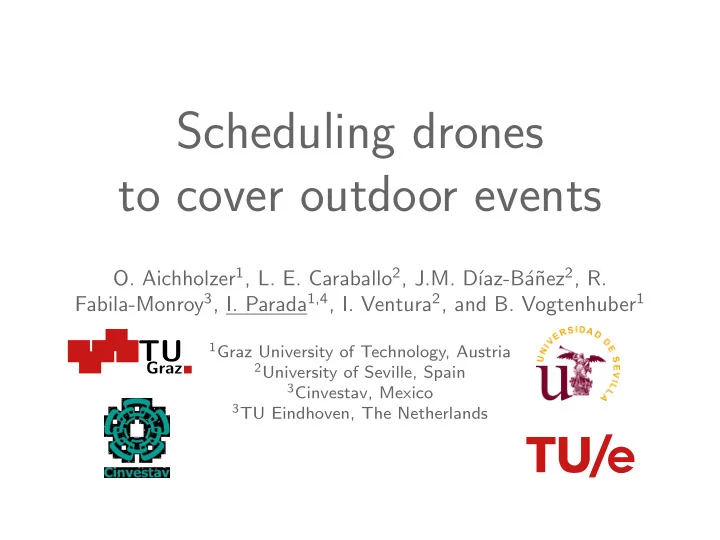

Scheduling drones to cover outdoor events O. Aichholzer 1 , L. E. Caraballo 2 , J.M. D´ nez 2 , R. ıaz-B´ a˜ Fabila-Monroy 3 , I. Parada 1,4 , I. Ventura 2 , and B. Vogtenhuber 1 TU 1 Graz University of Technology, Austria Graz 2 University of Seville, Spain 3 Cinvestav, Mexico 3 TU Eindhoven, The Netherlands
One drone (unlimited battery) p 3 = (19 , 12) p 2 = (1 , 10) 12:30–16:00 Each event i has: 11:30–12:15 12:45–14:30 - a location p i and 11:30–12:00 - a time interval I i . p 1 = (12 , 5) p 4 = (26 , 2) 9:15–12:00 base 15:00–17:00 9:15–11:00 p ∗ = (6 , 2) 15:00–17:00 Goal: Film as much (time) as possible. Lemma: There is an optimal plan in which the drone does not leave an event before it has ended.
One drone (unlimited battery) 9 10 11 12 13 14 15 16 17 I 1 I 3 I 4 I 2 shift I 1 I 3 I 4 I 2 shift I 1 I 3 I 4 I 2 Goal: Film as much (time) as possible. Lemma: There is an optimal plan in which the drone does not leave an event before it has ended.
One drone (unlimited battery) We construct a directed (acyclic) graph G = ( V, E ) . • V : base p ∗ and the points p i . • E : ( p i , p j ) iff a drone leaving p i at the end of I i can arrive to p j at a time t ∈ I j := [ a, b ] ; weight = b − t . Every ( p ∗ , p i ) is an edge with weight | I i | . We can compute E efficiently in O ( n 5 / 3 + | E | ) time: ( x, y ) at time t ⇒ ( x, y, t ) ∈ R 3 ⇒ ( x, y, t, x 2 , y 2 , z 2 ) ∈ R 6 using halfspace reporting queries in R 6 we determine E . Our problem translates to finding a directed path in G from p ∗ of max weight: topo. sort + dynamic programming. Optimal flight plan in O ( n 5 / 3 + | E | ) time.
k drones (unlimited battery) Lemma: There is an optimal plan in which: a) no drone leaves an event before it has ended and b) no two drones film at the same point at the same time. We introduce a second operation: swap • Do shifts until every drone leaves an event either at the end or when another drone arrives. • Do swaps until a) is satisfied.
k drones (unlimited battery) Lemma: There is an optimal plan in which: a) no drone leaves an event before it has ended and b) no two drones film at the same point at the same time. We construct the same DAG G = ( V, E ) as before. Our problem translates to finding a set of k disjoint paths in G starting at p ∗ of max weight. NP-complete for general graphs, but polynomial for DAGs. Optimal flight plan in O ( n 2 (log n + k ) + n | E | ) time. Min. # drones to cover it all in O ( n 5 / 3 + √ n | E ′ | ) time.
One drone with limited battery The set of theoretically relevant event-times for an optimal solution can be discretized. Moreover, an optimal solution can be encoded using a linear number of driving instructions. Applying dynamic programming we can compute an optimal sequence of instructions in polynomial time.
Conclusions We studied the problem of optimally scheduling drones to film n events happening at certain time intervals in different places. • One drone with no battery constraints: O ( n 5 / 3 + | E | ) algorithm, where | E | = O ( n 2 ) . • k drones with no battery constraints: O ( n 2 (log n + k ) + n | E | ) algorithm, where | E | = O ( n 2 ) . • Polynomial algorithm for one drone with limited battery. • NEW! k drones with limited battery: NP-hard. Thank you!
Recommend
More recommend